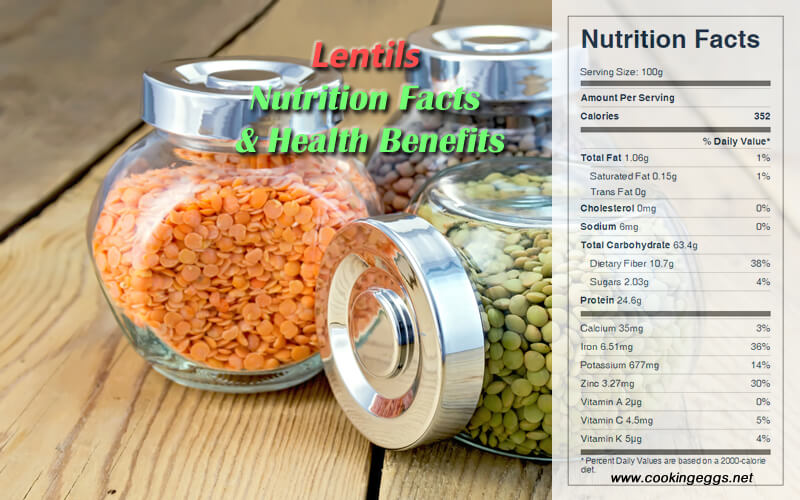Lentils Nutrition Facts & Health Benefits
Lentils are a diet staple the world over, often served with grains such as barley. Lentils are members of the legume family. They are an excellent source of protein and fiber. Here are the nutritional benefits of lentils.

The nutritional composition of lentils
One-half cup of cooked lentils provides 115 calories, 20 g carbohydrate, 9 g protein, 0.4 g fat, 7.8 g dietary fiber, 8 IU vitamin A, 1.5 mg vitamin C, 1 mg niacin, 0.63 mg pantothenic acid, 179 mcg folic acid, 365.5 mg potassium, 2 mg sodium, 178 mg phosphorus, 19 mg calcium, 3.3 mg iron, 35.5 mg magnesium, 1.25 mg zinc, and 0.49 mg manganese.
Raw lentils are 8% water, 63% carbohydrates, including 11% dietary fiber, 25% protein, and 1% fat. Boiled lentils are a rich source of numerous essential nutrients, including folate, iron, manganese, and phosphorus. They are a good source of several nutrients, including thiamine, pantothenic acid, vitamin B6, magnesium, copper, and zinc. When lentils are cooked by boiling, protein content declines to 9% of total composition, and B vitamins and minerals decrease due to the overall water content increasing (protein itself is not lost). Lentils have the second-highest ratio of protein to food energy of any legume, after soybeans. Lentils contain the carotenoids lutein and zeaxanthin, as well as polyunsaturated fatty acids.
Lentils Nutrition Facts Label
Health Benefits of Lentils
In 100 grams of cooked lentils, you can gain 17 grams of protein and 15 grams of fiber, which makes them a truly nutrient-dense food.
Lentils are among the legumes that are highest in protein. They are low in two essential amino acids and need to be balanced by grains to provide complete protein, but when paired with whole grains they can provide the complete nine essential amino acids. This pairing maximizes protein consumption.
In addition to providing protein and fiber, lentils are a good source of thiamine and other B vitamins, potassium, and iron. Because much of their fiber is soluble, they are helpful in stabilizing blood sugar and lowering cholesterol.
This legume is rich in protein, minerals, and fiber, is a good source of B vitamins, and is very low in fat. These complex carbohydrates are now recommended to us by cardiologists and diet advisors alike.
Flavor lentils with herbs and spices such as cumin, fennel, and garlic, which help to counter flatulence.
The abundant fiber content makes lentils an excellent prebiotic carbohydrate that fertilizes and nourishes the gut microbial environment and helps maintain the integrity of the gut.
Lentils are also a great source of iron. Studies have shown that the regular consumption of cooked lentils can prevent iron deficiency anemia.
When compared to other legumes, lentils have one of the highest total phenolic compounds, with different groups of the compounds such as procyanidin and prodelphinidin. The array of phenolic compounds exerts their effects as antioxidants, antibacterial, anti-inflammatory, and anticancer properties. Studies have shown that lentils have higher free radical scavenging abilities when compared to other plant-based foods such as blueberries, onions, and potatoes.
Lentils also contain a significant amount of folate and magnesium. Folate is important for lowering homocysteine levels. Homocysteine is an amino acid important to our body’s detoxing process. In the presence of folate and other B vitamins, homocysteine gets converted to cysteine or methionine. When we have low folate or B vitamins, homocysteine levels increase in the blood, which is not a good thing! Elevated homocysteine levels in the blood can cause artery damage, increasing the risk of developing heart disease. magnesium deficiency as a risk factor for heart attacks, but even further low magnesium levels after a heart attack can increase injury to the heart from free radicals.
Lentils also contain a bioactive peptide called "defensin," which has antimicrobial activities against bacteria and fungi. In addition, defensins can stop viral replication and inhibit protein translation in viruses. The lectin content in lentils provides them with anticancer properties. These lectins can bind to cancer cell membranes and receptors, inhibiting their growth and leading to cell death. They produce this effect by binding to ribosomes and inhibiting protein synthesis.
Lentils may be beneficial to diabetics due to their low levels of readily digestible starch (5%) and high levels of slowly digested starch. The remaining 65% of the starch is a resistant starch classified as RS1. A minimum of 10% of starch from lentils escapes digestion and absorption in the small intestine (therefore called "resistant starch"). Additional resistant starch is synthesized from gelatinized starch during cooling, after lentils are cooked.
Lentils also have antinutrient factors, such as trypsin inhibitors and a relatively high phytate content. Trypsin is an enzyme involved in digestion, and phytates reduce the bioavailability of dietary minerals. The phytates can be reduced by prolonged soaking, fermentation, or sprouting. Cooking nearly completely removes the trypsin inhibitor activity; sprouting is also effective.